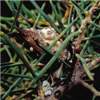Synonymy
Hakea oldfieldii Benth., Fl. Austral. 5: 530 (1870)
T: Champion Bay, Western Australia, A.F.Oldfield s.n.; syn: MEL 108007, PERTH. Excluded syntype: In the interior, Western Australia, without date, J.S.Roe s.n.; syn: K (= H. newbeyana )
Hakea sp. 'Williamson' (B.J.Keighery & N.Gibson 226), WA Herbarium census.
Description
Shrub with branches erect, 1–3 m tall. Branchlets glabrous, glaucous. Leaves simple- or rarely compound-terete, 1–7 cm long, 0.7–1.8 mm wide, constricted basally, rigid, not grooved, glabrous, not glaucous; ultimate segments (when leaf compound) 2 or 3.
Inflorescence axillary raceme with 8–20 flowers; involucre 3–6 mm long; rachis 2–3 mm long, glabrous; pedicels 2.5–9.5 mm long. Perianth 1.5–2.5 mm long, cream-white. Pistil 3–4.5 mm long.
Fruit obliquely ovate, 1.6–2.3 cm long, 0.8–1 cm wide, finely and sparsely black-pusticulate, obscurely apiculate; horns 5 mm long. Seed obliquely narrowly obovate, 14–17 mm long; wing partly down one side of seed body only.
Distribution and ecology
Occurs in south-western WA from Bunbury and Busselton to Stirling Ra. The type, perhaps erroneously labelled, represents a disjunct old collection from Champion Bay (north side of Geraldton).
Found in winter-wet areas in Hakea/Melaleuca scrub in sand, well-drained gravelly loam, pebbly loam or red clay over ironstone.
To plot an up to date distribution map based on herbarium collections for this species see Australia's Virtual Herbarium. Localities outside the native range may represent cultivated or naturalised records.
Flowering time
Flowers Aug.–Oct.
Derivation of name
Named after Augustus Oldfield (1820-1887), who made numerous collections, particularly in
Relationships
Previously treated as Sect. Manglesioidesof Bentham. Sect. Manglesioides is characterised by a conical pollen presenter, obscurely veined leaves, glabrous perianths which are straight in bud and fruits with distinct horns. Treated as the Lissocarpha group in Barker et al. and having the same species as in Bentham's section.
Probably closest to Bentham's Section Conogynoides Series Enerves (the Varia group of Barker et al., 1999), since they share a conical pollen presenter, leaves without obvious venation and fruits with horns, but differ by the curved buds of the Varia group as opposed to the straight buds of the Lissocarpha group. Neither of these informal groups is considered to be part of Sect. Conogynoides.
Members of the group are H. drupacea, H. lissocarpha, H. nitida and H. oldfieldii, and all are found in SW Western Australia. The first three of these also produce pink pollen, another characteristic which is unusual in Hakea.
The only other species outside this group to exhibit the characteristic of straight buds is another species from the south-west, H. newbeyana .
Notes
The type collections by Oldfield and Roe represent two different species, that of Oldfield representing the species usually referred to as H. oldfieldii, while the Roe collection is H. newbeyana. The only material found to have been annotated by Bentham is the Roe collection at K, but this is at variance with the protologue since it is not glabrous in all parts and does not have a glabrous rachis of 1–2 lines long. The Oldfield collection is in keeping with the protologue, but there is apparently no specimen at K. The only Oldfield collection seen in MEL has not been annotated by Bentham, suggesting that there may be a specimen still to be located in K. The fragment in PERTH must come from either this as yet to be located K specimen or from the MEL specimen. Because the Oldfield collection agrees best with the protologue, and also agrees with current usage, it should be chosen as the lectotype. However, this cannot be done until a more thorough search has been made at K.
Judging by collections, H. oldfieldii is a relatively rare species, while H. newbeyana is more common. Both species have straight buds. Hakea oldfieldii can be distinguished by its glabrous branchlets and leaves, cream-white flowers and smaller (1.6–2.3 cm long) fruit. Hakea newbeyana has appressed-ferruginous hairs on the branchlets and young leaves, yellow flowers and larger (2.5–3.5 cm long) fruit.
Conservation status
In Western Australia denoted as Priority Three - Poorly Known: taxa which are known from several populations, at least some of which are not believed to be under immediate threat (i.e. not currently endangered). Such taxa are under consideration for declaration as ‘rare flora’, but are in need of further survey. (listing current August 2006).
Atkins, K.J. (2008). Declared Rare and Priority Flora List for
Representative specimens
Western Australia: Mt Wells, H.Demarz 1688 (PERTH); 16 km NE of Twin Peaks, Porongorup Ra., K.Newbey 9424 (PERTH); Chester Pass, Stirling Ra., R.D.Royce 3700 (PERTH); Ruabon, Busselton District, R.D.Royce 4512 (PERTH).
Weblinks
Link to FloraBase treatment of this species for WA.
Further illustrations
I. Holliday, Hakeas. A Field and Garden Guide 150-1 (2005)
J.A..Young, Hakeas of Western Australia. A Field and Identification Guide 81 (2006)



